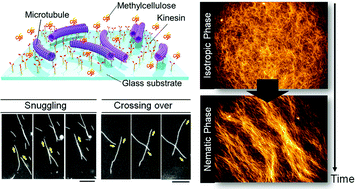Depletion force induced collective motion of microtubules driven by kinesin†
Abstract
Collective motion is a fascinating example of coordinated behavior of self-propelled objects, which is often associated with the formation of large scale patterns. Nowadays, the in vitro gliding assay is being considered a model system to experimentally investigate various aspects of group behavior and pattern formation by self-propelled objects. In the in vitro gliding assay, cytoskeletal filaments F-actin or microtubules are driven by the surface immobilized associated biomolecular motors myosin or dynein respectively. Although the F-actin/myosin or microtubule/dynein system was found to be promising in understanding the collective motion and pattern formation by self-propelled objects, the most widely used biomolecular motor system microtubule/kinesin could not be successfully employed so far in this regard. Failure in exhibiting collective motion by kinesin driven microtubules is attributed to the intrinsic properties of kinesin, which was speculated to affect the behavior of individual gliding microtubules and mutual interactions among them. In this work, for the first time, we have demonstrated the collective motion of kinesin driven microtubules by regulating the mutual interaction among the gliding microtubules, by employing a depletion force among them. Proper regulation of the mutual interaction among the gliding microtubules through the employment of the depletion force was found to allow the exhibition of collective motion and stream pattern formation by the microtubules. This work offers a universal means for demonstrating the collective motion using the in vitro gliding assay of biomolecular motor systems and will help obtain a meticulous understanding of the fascinating coordinated behavior and pattern formation by self-propelled objects.


 Please wait while we load your content...
Please wait while we load your content...